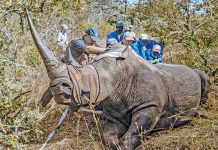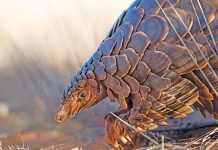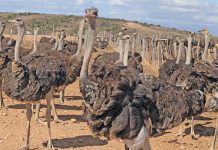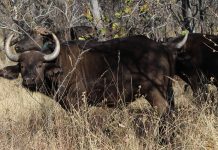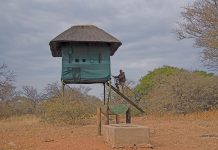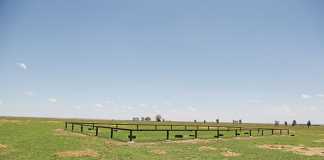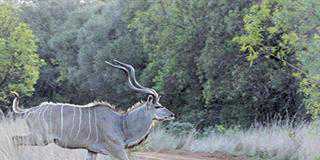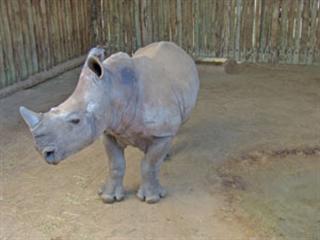
Capturing and moving game is a dangerous occupation as Dr Markus Hofmeyr, head of South African National Parks’ Veterinary Wildlife Services, can attest. In October 2010 trialling an immobilising drug for hippo in the Crocodile River, Dr Hofmeyr narrowly escaped death when a darted hippopotamus charged him. Quick-acting colleague, Dr Nico de Bruin, pulled him to safety. Dr Hofmeyr has been involved in many capture and translocation projects, including the relocation of 25 black rhino from South Africa to Zambia.
This project was run in collaboration with regional conservation agencies in Southern Africa, the Frankfurt Zoological Society and Zambia Wildlife Authority. “The core function of my department is capturing, moving and handling animals,” says Dr Hofmeyr, based at the Kruger National Park (KNP). “Our department has two wings, the operational wing and the veterinary wing.” He explains that the operations unit deals with animal capture, holding bomas, transporting, feeding and handling.
The veterinary unit deals with drug use, diagnostic test development, capturing and collaring techniques and procedures and ethical handling of drugs and animals. “We work to improve our diagnostics and techniques,” says Dr Hofmeyr. Sharing skills, Wildlife Services collaborates with its counterparts in Mozambique, Botswana, Zimbabwe and Namibia. Other parks in the region have lost animals to the ravages of civil war and uncontrolled poaching. Countries that have suffered high wildlife mortality rates are keen to reintroduce game animals.
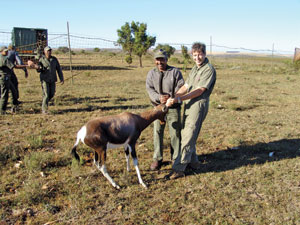
Net capture is one form of capturing game. This bontebok has been extricated from the net prior to being loaded onto a truck. Field ranger Januarie (left) and ex SANParks pilot Henny de Waal are holding the bontebok.
“Since 2000, we have moved about 5 000 animals to areas in Mozambique where they were previously poached out,” says Dr Hofmeyr. “Currently we are translocating large numbers of zebra, wildebeest and a few giraffe to Mozambique’s Zinave National Park.”
Disease threat
Strict controls are in place to prevent the spread of disease by wild animals. Of primary concern is foot-and-mouth disease and bovine tuberculosis which is carried by buffalo in the Kruger National Park. “Buffalo picked up TB in the early 1950s from cattle and it has now spread throughout the park. There is a risk that infection could be passed on to other animals such as lion feeding on the carcasses of infected animals.”
As a population conservation measure, the KNP strategically relocates rhino from the KNP to other reserves and private game farms. This reduces the risk of exposure to poaching and generates income for conservation projects. “White rhino, black rhino, hippo, elephant and zebra are not susceptible to TB and can be moved without testing. But, animals must be healthy before they can be moved.”
Seasonal activity
SANParks moves between 1 000 and 4 000 animals within the region every year, depending on the annual programme. Planning and research is done between November and February. The hot rainy season is not a good time for capture and translocation. Females are calving or lambing and roads are waterlogged and difficult to navigate in heavy vehicles. “High temperatures also cause added stress to the animals,” says Dr Hofmeyr.
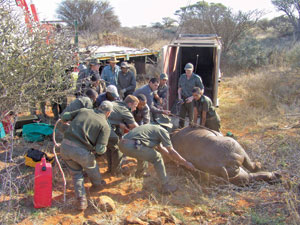
This black rhino cow is about to go into a specialised transport crate. The immobilising agent is partially reversed and the animal is rope guided into the crate. Once she is safely inside additional reversal is administered.
“The capture season starts in March and is distinctly linked to climatic conditions. Some years we move only a few animals, but then we handle many more, either to collar or to take samples for research.”
Game flow
In the past, buffalo were imported from foreign zoos because of the local scarcity of disease-free buffalo. Rare antelope such as sable have also been shipped in. Although most animals currently translocated go to Mozambique, a number are moved to Zambia, Tanzania and Botswana. South Africa has obtained the south-western black rhino subspecies (Diceros bicornis bicornis), from Namibia.
About 30 to 40 western black rhino have been brought into South Africa in the past two decades. “It isn’t a big number, but it is one hell of a logistics nightmare to bring a rhino into the country,” Dr Hofmeyr admits. “Aside from the permits and trucks required, they are very difficult animals to re-introduce into a new environment.”
Black rhino are established in the western national parks such as the Karoo, Mountain Zebra and Addo Elephant parks, as the subspecies is arid environment adapted. “Namibia can supply us with black rhino of the south-western subspecies and in return, we could supply Namibia with white rhino,” explains Dr Hofmeyr. The south-western black rhino occurs only in Namibia and South Africa. Dr Hofmeyr says that both species of rhino have healthy, viable populations in the KNP.
Anti-poaching
The Veterinary Wildlife Services’ involvement with poaching extends to conducting autopsies on rhino, freshly killed by poachers. Samples are collected and bullets retrieved for forensic purposes. “If an animal has been shot, we find the bullet when we do the post-mortem. This can be used in forensic follow-ups to identify weapons.” The KNP has a bio-bank
which provides a reference collection of all species that have been worked with.
“Whenever we handle an animal, we take samples of blood, tissue and hair for research purposes, but some of the material is set aside and banked,” he explains. This material is in demand by scientists investigating various genetic and immune responses and examining reactions to historical disease events. The samples and data of poached animals is collected and analysed by the Onderstepoort forensic laboratory. Samples can be used to match recovered horns or horn material.
ranching and national parks Game animals from SANParks are supplied to the private game ranching sector. “Because game ranchers breed colour variants and hunting dictates selection for trophy horn sizes and larger animals, there is a risk that viable heterogenous genetics could be eroded in the private game ranch industry.”
Dr Hofmeyr says that SANParks have large populations of indigenous wildlife that are not selected in any way. SANParks currently has the largest herd of Kruger genetics buffalo outside the Park in Mokola in Northern Cape Province. “These populations can provide a source of new genetics for the game ranching industry. This is a win-win relationship in which SANParks earn income from wildlife sales and private ranchers obtain good genetics.”
Contact Dr Markus Hofmeyr on 013 735 4239 or at [email protected]

